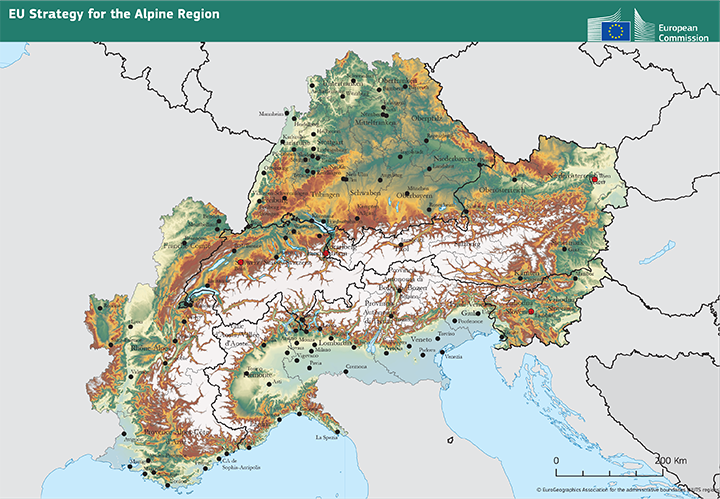An EU Strategy for the Alpine Region
NEWS
The EU Strategy for the Alpine Region involves 7 countries: Austria, France, Germany, Italy, Liechtenstein, Slovenia and Switzerland.

It builds on the experiences of the already existing macro-regional strategies: the European Strategy for the Danube Region and the European Strategy for the Baltic Sea Region and the European Strategy for the Adriatic and Ionian Region.
The Commission adopted a Communication and an Action Plan on the EU Strategy for the Alpine Region on 28 July 2015 . This followed the invitation from the European Council in December 2013. It also took account – inter alia – of the on-line public consultation that was held in 2014, and the debates and discussions in the Stakeholder Conference on the EU Strategy for the Alpine Region (Milano, December 2014).
The Alpine region is one of the largest economic and productive regions in Europe where about 70 million people live and work, as well as it is an attractive tourist destination for millions of guests every year. However, it faces several major challenges:
- Economic globalisation requiring the territory to distinguish itself as competitive and innovative
- Demographic trends characterised by ageing and new migration model
- Climate change and its foreseeable effects on the environment, biodiversity and living conditions of the inhabitants
- Energy challenge at the European and worldwide scale. Its specific geographical position in Europe as a transit region but also as an area with unique geographical and natural features
Better cooperation between the regions and States is needed to tackle those challenges.
The main added value of the Strategy for the Alpine Region will consist in a new relationship between metropolitan, peri-mountain, and mountain areas. According to the political resolution adopted by the representatives of the 7 Alpine States and 15 Alpine Regions in Grenoble in October 2013, the new strategy will focus on the following 3 thematic priorities:
- Competitiveness and Innovation
- Environmentally friendly mobility
- Sustainable management of energy, natural and cultural resources
The Strategy does not come with extra EU finance but it is supported from the resources already available according to an integrated approach. Countries may also make use of the funding they receive through EU cohesion policy, other EU programmes and financial instruments, and various international financial institutions.
To know more about financial opportunities visit
EuroAccess
- Since 2004, the majority of the countries in the Alpine region are EU countries.
- Many of the problems are covered by EU policy.
- As an independent player with respected authority, the EU is in a good position to facilitate cooperation.
- The EU already runs programmes in the region and so can provide opportunities for cooperation.
To get in contact with the EUSALP team in DG REGIO, please email the secretary of the REGIO. DDG.D1: REGIO-TRANSNATIONAL-AND-INTERREGIONAL-COOPERATION@ec.europa.eu. For more information on how to get in contact with EUSALP stakeholders, please visit the EUSALP website .

